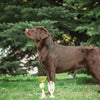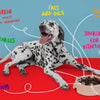Feeding Your Dog Properly: A Guide to Canine Nutrition
- by Robert Wolff
When it comes to caring for your furry friend, proper nutrition is one of the most important aspects of their overall health and well-being. Feeding your dog properly ensures they have the energy to play, learn, and thrive while avoiding common health issues. In this guide, we’ll cover the essentials of canine nutrition, including choosing the right food, understanding portion sizes, and incorporating healthy treats.
1. Choose the Right Dog Food
The foundation of your dog’s diet starts with selecting the right food. Not all dog foods are created equal, so it’s crucial to choose a high-quality option that meets their specific needs. Consider the following factors:
-
Age: Puppies, adults, and senior dogs have different nutritional requirements. Look for age-specific formulas to ensure your dog gets the right balance of nutrients.
-
Size and Breed: Larger breeds often need more calories and joint-supporting nutrients, while smaller breeds may benefit from foods with higher protein content.
-
Health Conditions: Dogs with allergies, sensitive stomachs, or medical conditions may require specialized diets. Consult your veterinarian for recommendations.
Always check the ingredient list. High-quality dog foods will list a named protein source (e.g., chicken, lamb, or salmon) as the first ingredient and avoid fillers like corn, wheat, and artificial preservatives.

2. Understand Portion Sizes
Feeding your dog the right amount is just as important as choosing the right food. Overfeeding can lead to obesity, while underfeeding can cause malnutrition. Here’s how to determine the appropriate portion size:
-
Follow the Guidelines: Most commercial dog foods provide feeding guidelines based on your dog’s weight and activity level. Use these as a starting point.
-
Monitor Weight: Regularly check your dog’s weight and body condition. If they’re gaining or losing weight, adjust portion sizes accordingly.
-
Consider Activity Level: Highly active dogs may need more calories, while less active dogs may require fewer.
Remember to measure your dog’s food with a standard measuring cup to avoid overfeeding.

3. Incorporate Healthy Treats
Treats are a great way to reward your dog, but they should only make up a small portion of their daily caloric intake (usually no more than 10%). Opt for healthier treat options like:
-
Fresh fruits and vegetables (e.g., carrot sticks, apple slices without seeds)
-
Commercial dog treats made with natural ingredients
-
Homemade treats made from simple, dog-safe ingredients
Avoid feeding your dog toxic foods like chocolate, grapes, raisins, onions, or anything containing xylitol.

4. Maintain a Consistent Feeding Schedule
Dogs thrive on routine, and feeding them at the same times each day can help with digestion and prevent begging. Most dogs do well with two meals a day—morning and evening—but puppies and some breeds may require more frequent meals.
5. Provide Fresh Water
A balanced diet isn’t complete without access to clean, fresh water. Make sure your dog’s water bowl is always full and cleaned regularly to encourage hydration.
6. Monitor Your Dog’s Health
Feeding your dog properly also involves paying attention to how their diet affects their health. Look out for signs of digestive issues, skin problems, or changes in energy levels. If you notice anything unusual, consult your veterinarian.
Conclusion
Feeding your dog properly is a cornerstone of responsible pet ownership. By choosing high-quality food, managing portion sizes, incorporating healthy treats, and maintaining a consistent routine, you can ensure your dog stays happy and healthy for years to come. Remember, every dog is unique, so consult your veterinarian to tailor your approach to your pet’s specific needs.



